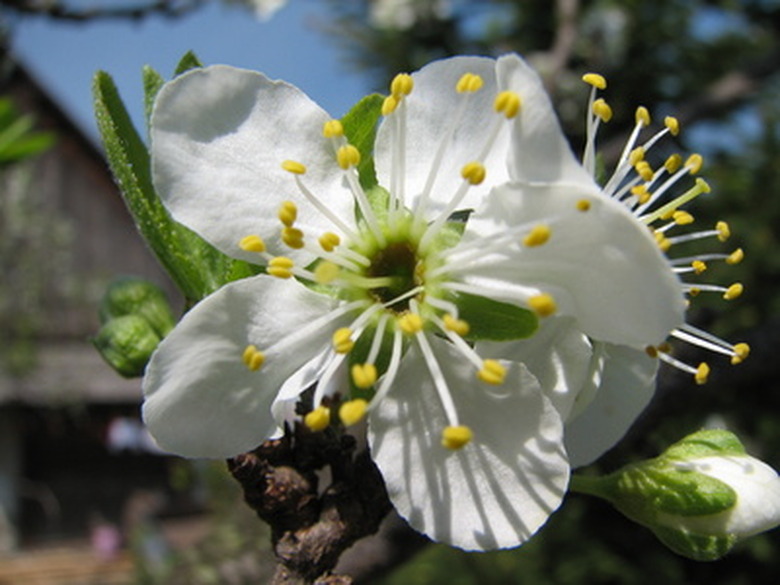Facts About Bruce Plum Trees
Like their cherry, apricot and peach relatives, plums are members of the rose family and form stone fruits: having a hard seed pit in their centers. The variety 'Bruce' develops fruits with a sweet but mellow flavor. Plant an additional plum tree nearby to ensure excellent pollination of flowers in very early spring. Cool, rainy weather in early spring followed by irregular late frosts can diminish flowering and fruiting on 'Bruce'. Grow it in USDA hardiness zones 6 through 8.
Origins
This hybrid plum resulted from a genetic cross between the Japanese plum (Prunus salicina) and the American native Chickasaw plum (Prunus angustifolia). As such, its proper botanical name is Prunus 'Bruce', although many list or sell this variety as Prunus salicina 'Bruce'. It was introduced into trade in 1921 by A. L. Bruce of Donelly County, Texas.
- Like their cherry, apricot and peach relatives, plums are members of the rose family and form stone fruits: having a hard seed pit in their centers.
- As such, its proper botanical name is Prunus 'Bruce', although many list or sell this variety as Prunus salicina 'Bruce'.
Description
Growing to a mature size of about 15 to 20 feet, its branches and canopy are open and spreading in habit. Depending on climate, the small five-petaled white flowers begin opening in very late winter to early spring, making them prone to late frosts. The leaves are medium green and tapering ovals. The abundant numbers of fruits ripen with skins of translucent salmony orange-red with sweet yellow flesh. Harvest them in late spring; this is a very early-season plum.
Growing Requirements
Plant Bruce plum in a fertile, moist but well-draining soil in full sun, receiving at least 8 hours of direct sunlight daily. It tolerates high summer heat and humidity and many soil types. The Japanese plum lineage tends to give this variety a "self-fertile" quality, meaning its own flower numbers should result in adequate pollination by honeybees. For excellent fruit set, consider planting at least two trees within 100 feet of each other for heightened cross-pollination. Variety 'Methley' is a good companion pollinator tree. The Bruce plum needs 500 chilling hours in winter in order to flower and fruit. In some colder winter areas of USDA zone 9, this variety may be worthwhile.
- Growing to a mature size of about 15 to 20 feet, its branches and canopy are open and spreading in habit.
- The Japanese plum lineage tends to give this variety a "self-fertile" quality, meaning its own flower numbers should result in adequate pollination by honeybees.
Considerations
If untimely spring frosts often occur in your area and threaten harming the plum's blossoms, situate the tree on a sunny hillside slope and out of cold winds, perhaps sheltered near an outbuilding or evergreen grove. Do not plant in low areas prone to settling cold air pockets. If blossoms turn black after a frost, they will not develop into fruits. Reduce use of pesticides in your overall landscape to ensure that pollinating insects are always in their highest numbers.
Uses
If fruit set is not important, Bruce plum acts as an attractive small flowering tree with a rustic appearance. The white flowers look best when contrasted from behind by a dark-colored structure or evergreen tree. The fruits ripen early and will attract birds; eat the fruits fresh, preserved in jams and jellies, or canned.
- If untimely spring frosts often occur in your area and threaten harming the plum's blossoms, situate the tree on a sunny hillside slope and out of cold winds, perhaps sheltered near an outbuilding or evergreen grove.
